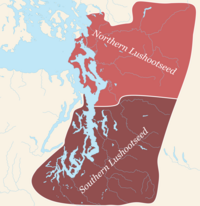Related Research Articles

The Salishan languages are a family of languages of the Pacific Northwest in North America. They are characterised by agglutinativity and syllabic consonants. For instance the Nuxalk word clhp’xwlhtlhplhhskwts’, meaning "he had had [in his possession] a bunchberry plant", has twelve obstruent consonants in a row with no phonetic or phonemic vowels.
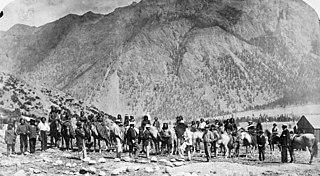
The Stʼatʼimc, also known as the Lillooet, St̓át̓imc, or Stl'atl'imx, are an Interior Salish people located in the southern Whale Mountains and Fraser Canyon region of the Interior of the Canadian province of British Columbia.
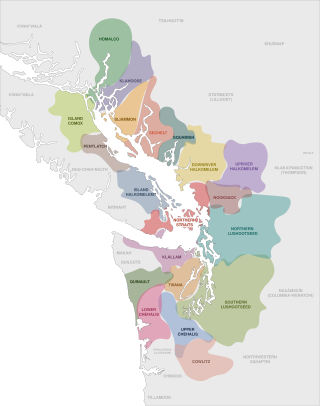
The Coast Salish languages, also known as the Central Salish languages, are a branch of the Salishan language family. These languages are spoken by First Nations or Native American peoples inhabiting the Pacific Northwest, in the territory that is now known as the southwest coast of British Columbia around the Strait of Georgia and Washington State around Puget Sound. The term "Coast Salish" also refers to the cultures in British Columbia and Washington who speak one of these languages or dialects.

The Bitterroot Salish are a Salish-speaking group of Native Americans, and one of three tribes of the Confederated Salish and Kootenai Tribes of the Flathead Nation in Montana. The Flathead Reservation is home to the Kootenai and Pend d'Oreilles tribes also. Bitterroot Salish or Flathead originally lived in an area west of Billings, Montana extending to the continental divide in the west and south of Great Falls, Montana extending to the Montana–Wyoming border. From there they later moved west into the Bitterroot Valley. By request, a Catholic mission was built here in 1841. In 1891 they were forcibly moved to the Flathead Reservation.

The Pend d'Oreille or Pend d'Oreilles, also known as the Kalispel, are Indigenous peoples of the Northwest Plateau. Today many of them live in Montana and eastern Washington of the United States. The Kalispel peoples referred to their primary tribal range as Kaniksu.
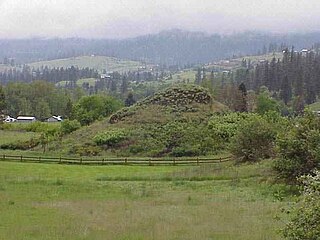
Indigenous peoples of the Northwest Plateau, also referred to by the phrase Indigenous peoples of the Plateau, and historically called the Plateau Indians are Indigenous peoples of the Interior of British Columbia, Canada, and the non-coastal regions of the Northwestern United States.
Lillooet is a Salishan language of the Interior branch spoken by the Stʼatʼimc in southern British Columbia, Canada, around the middle Fraser and Lillooet Rivers. The language of the Lower Lillooet people uses the name Ucwalmícwts, because St̓át̓imcets means "the language of the people of Sat̓", i.e. the Upper Lillooet of the Fraser River.

Coyote is a mythological character common to many cultures of the Indigenous peoples of North America, based on the coyote animal. This character is usually male and is generally anthropomorphic, although he may have some coyote-like physical features such as fur, pointed ears, yellow eyes, a tail and blunt claws. The myths and legends which include Coyote vary widely from culture to culture.
The Interior Salish languages are one of the two main branches of the Salishan language family, the other being Coast Salish. It can be further divided into Northern and Southern subbranches. The first Interior Salish people encountered by American explorers were the Flathead people.
Nicola, also Nkwala or N'kwala, was an important First Nations political figure in the fur trade era of the British Columbia Interior as well as into the colonial period (1858–1871). He was grand chief of the Okanagan people and chief of the Nicola Valley peoples, an alliance of Nlaka'pamux and Okanagans and the surviving Nicola Athapaskans, and also of the Kamloops Band of the Shuswap people.

The Syilx people, also known as the Okanagan, Suknaqinx, or Okinagan people, are a First Nations and Native American people whose traditional territory spans the Canada–US boundary in Washington state and unceded British Columbia in the Okanagan Country region. They are part of the Interior Salish ethnological and linguistic grouping. The Okanagan are closely related to the Spokan, Sinixt, Nez Perce, Pend Oreille, Secwepemc and Nlaka'pamux peoples of the same Northwest Plateau region.
Okanagan, or Colville-Okanagan, or Nsyilxcən, is a Salish language which arose among the Indigenous peoples of the southern Interior Plateau region based primarily in the Okanagan River Basin and the Columbia River Basin in precolonial times in Canada and the United States. Following British, American, and Canadian colonization during the 1800s and the subsequent assimilation of all Salishan tribes, the use of Colville-Okanagan declined drastically.

Squamish is a Coast Salish language spoken by the Squamish people of the Pacific Northwest. It is spoken in southwestern British Columbia, Canada, centred on their reserve communities in Squamish, North Vancouver, and West Vancouver. An archaic historical rendering of the native Sḵwx̱wú7mesh is Sko-ko-mish but this should not be confused with the name of the Skokomish people of Washington state. Squamish is most closely related to the Sechelt, Halkomelem, and Nooksack languages.
The Sts'ailes are an indigenous people from the Lower Mainland region of British Columbia, Canada.

Bryoria fremontii is a dark brown, horsehair lichen that grows hanging from trees in western North America, and northern Europe and Asia. It grows abundantly in some areas, and is an important traditional food for a few First Nations in North America.
Annie Zixtkwu York was a distinguished elder of the Nlaka'pamux people of the Spuzzum First Nation of Spuzzum, in Fraser Canyon located in the lower region of British Columbia, Canada. York was raised by her Nlaka'pamux family where she came to be bilingual speaking English and Nlaka'pamuctsin. She dedicated herself to the Christian religion and the beliefs of the Nlaka'pamux people, Nle'kepmx. York's family members educated her about the history of Spuzzum as well as the origin of its name, Spuzzum chiefs, and the ethnobotany of the region. York was known to be a storyteller, always recording and sharing stories.
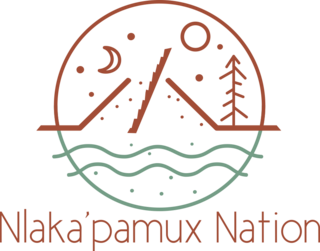
The Nlakaʼpamux or Nlakapamuk, also previously known as the Thompson, Thompson River Salish, Thompson Salish, Thompson River Indians or Thompson River people, and historically as the Klackarpun, Haukamaugh, Knife Indians, and Couteau Indians, are an Indigenous First Nations people of the Interior Salish language group in southern British Columbia. Their traditional territory includes parts of the North Cascades region of Washington.
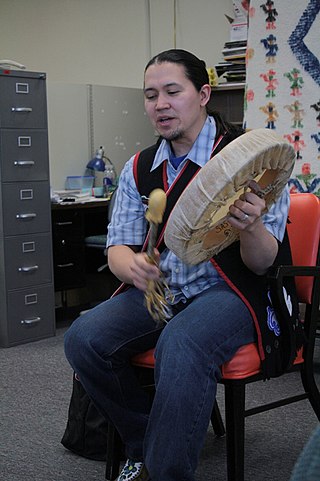
Alaska Native storytelling has been passed down through generations by means of oral presentation. The stories tell life lessons or serve as lessons in heritage. Many different aspects of Arctic life are incorporated into each story, mainly the various animals found in Alaska. Due to the decline in the number of speakers of native languages in Alaska and a change in lifestyle amongst many of the native peoples, oral storytelling has become less common. In recent years many of these stories have been written down, though many people argue that the telling of the story is just as important as the words within.

The Salish peoples are indigenous peoples of the American and Canadian Pacific Northwest, identified by their use of the Salishan languages which diversified out of Proto-Salish between 3,000 and 6,000 years ago.
References
- Thompson, M. Terry; Egesdal, Steven M. (eds.) (2008). Salish Myths and Legends: One People's Stories. Lincoln: University of Nebraska Press. ISBN 9780803210899.
{{cite book}}:|first2=has generic name (help) - Clark, Ella E. (1988). Indian Legends from the Northern Rockies (2nd ed.). Norman: University of Oklahoma Press. ISBN 9780806120874.
